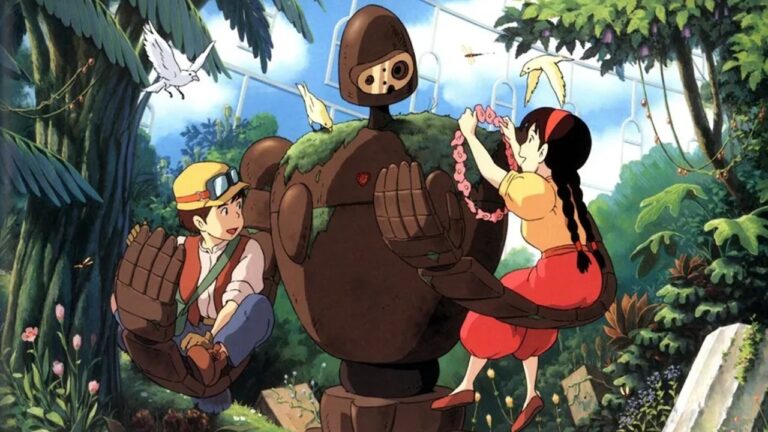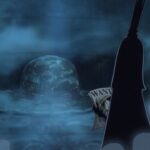The 1986 Ghibli studio movie, ‘Castle in the Sky,’ deserves the same recognition as the other works by Hayao Miyazaki. It is said that this movie remains one of Studio Ghibli’s most defining works, showing us a soaring mix of adventure in a world-building environmental theme that reflects the undeniable warmth of Miyazaki’s work.
The story is about a young orphan girl named Sheeta, who is being held against her wishes on an airship by a government agent named Muska. We see how she tries to escape during a pirate raid led by the formidable Dola, and eventually she falls from the sky, but her mysterious Aetherium crystal slows her descent and delivers her safely into the arms of Pazu, who is a young mechanic from a mining town shaped by 19th-century industry.
A Peaceful Morning Ends as Soldiers and Pirates Close In

The story eventually takes a dramatic turn, as audiences see Pazu showing Sheeta a cherished photo taken by his father, proof that he believes in the legendary floating island called Laputa. Their quiet morning is cut short when soldiers and Dola’s pirates arrive, leading to a chase through the town and into the mines, where they meet Uncle Pom. He recognizes Sheeta’s crystal as the same ancient material hidden deep within the earth. We discover that it is the first tangible clue that Laputa may be real. Sheeta reveals her birth name and connection to Laputa’s royal bloodline, just as the army captures them and takes them to an unknown fortress.
When they do reach the fortress, audiences witness something extraordinary. We come across a dormant Laputian robot that Muska shows Sheeta, confirming her ancestry with the beings and the island. He releases Pazu, using Sheeta to locate Laputa. But Pazu is quickly picked up by Dola’s crew, who want the crystal for themselves. When Sheeta accidentally activates an ancient spell, the robot awakens, unleashing staggering firepower that destroys the fortress before falling to the military ship Goliath. And amid all the destruction, we see how Pazu and Dola rescue Sheeta, but Muska escapes with the active crystal and a clear path to Laputa.
The movie takes a dramatic turn when we see Sheeta and Pazu join Dola to pursue him. A storm like the one from Pazu’s father’s tales leads them to Laputa, now overgrown with greenery and tended by a peaceful robot. The army soon arrives, only for Muska to betray them and seize control of the island’s core. Revealing himself as a fellow Laputan descendant, we see how he activates Laputa’s weapons, demonstrating its terrifying power by destroying Goliath.
Sheeta was very much horrified by his ambitions and did everything in her power to take back the crystal and flee. But Muska corners her in the throne room, and as we see, Pazu arrives, and together they recite the spell of destruction, triggering Laputa’s collapse. And the island’s great central tree protects them as the weapon systems crumble, as we see how the upper ruins float into space while Sheeta, Pazu, and Dola’s crew escape safely.
You may also like: ‘Grave of the Fireflies’ Remains One Of Cinema’s Most Devastating Portraits Of Innocence, Hayao Miyazaki’s ‘Princess Mononoke’ Transformed Environmentalism Into Art
Ghibli’s Early Years Push Animation Craft to New Heights

For those who don’t know, the significance of the film’s spirit comes from Miyazaki’s 1985 research trip to Wales, where he saw the impact of the miners’ strike and the resilience of working-class communities during that time. Their architecture, solidarity, and spirit were shaped through Pazu’s hometown and the miners who rushed to help the kids. And that is exactly what Miyazaki’s work conveyed, while showing those emotions in a story rooted in optimism and the belief in ordinary people.
Produced shortly after the founding of the production house of Studio Ghibli, the film set new standards for animated craftsmanship. With Isao Takahata insisting on top-tier quality, the team made sure to blend the traditional cel animation with inventive camera work, supported by studios like Doga Kobo and Oh! Production.
With such incredible storytelling, one thing that deserves the most attention is how artistry and world-building are always centered around environmental issues. And that is something that Ghibli has been trying to show from the very beginning with all of their works till this day.
Read more: ‘The Wind Rises’: Hayao Miyazaki’s Poetic Farewell to Flight and Dreams, Upcoming ‘Assassination Classroom’ Movie Promises the Anime’s Most Untold Chapter Yet




